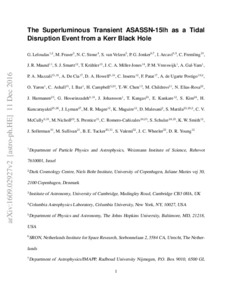The superluminous transient ASASSN-15lh as a tidal disruption event from a Kerr black hole
Leloudas G.; Fraser M.; Stone N. C.; van Velzen S.; Jonker P. G.; Arcavi I.; Fremling C.; Maund J. R.; Smartt S. J.; Krìhler T.; Miller-Jones J. C. A.; Vreeswijk P. M.; Gal-Yam A.; Mazzali P. A.; De Cia A.; Howell D. A.; Inserra C.; Patat F.; de Ugarte Postigo A.; Yaron O.; Ashall C.; Bar I.; Campbell H.; Chen T.-W.; Childress M.; Elias-Rosa N.; Harmanen J.; Hosseinzadeh G.; Johansson J.; Kangas T.; Kankare E.; Kim S.; Kuncarayakti H.; Lyman J.; Magee M. R.; Maguire K.; Malesani D.; Mattila S.; McCully C. V.; Nicholl M.; Prentice S.; Romero-Cañizales C.; Schulze S.; Smith K. W.; Sollerman J.; Sullivan M.; Tucker B. E.; Valenti S.; Wheeler J. C.; Young D. R.
https://urn.fi/URN:NBN:fi-fe2021042715945
Tiivistelmä
When a star passes within the tidal radius of a supermassive black hole, it will be torn apart1. For a star with the mass of the Sun (M ⊙) and a non-spinning black hole with a mass <108 M ⊙, the tidal radius lies outside the black hole event horizon2 and the disruption results in a luminous flare3-6. Here we report observations over a period of ten months of a transient, hitherto interpreted7 as a superluminous supernova8. Our data show that the transient rebrightened substantially in the ultraviolet and that the spectrum went through three different spectroscopic phases without ever becoming nebular. Our observations are more consistent with a tidal disruption event than a superluminous supernova because of the temperature evolution6, the presence of highly ionized CNO gas in the line of sight9 and our improved localization of the transient in the nucleus of a passive galaxy, where the presence of massive stars is highly unlikely10,11. While the supermassive black hole has a mass >108 M ⊙ 12,13, a star with the same mass as the Sun could be disrupted outside the event horizon if the black hole were spinning rapidly14. The rapid spin and high black hole mass can explain the high luminosity of this event.
Kokoelmat
- Rinnakkaistallenteet [27094]
